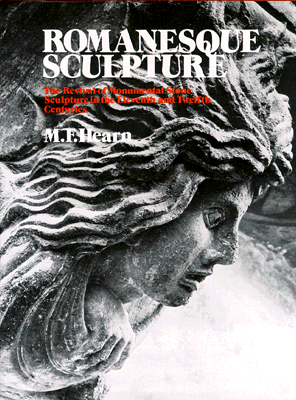

Romanesque Sculpture: The Revival of Monumental Stone Sculpture in the Eleventh and Twelfth Centuries, 240 pages, 161 illustrations,
Sub-title dominant, this book on the stages of the revival of the monumental human figure in sculpture in the Romanesque era was, when published in 1981, the first substantial treatment of the evolution of Romanesque sculpture since 1923, and it has had no successors. It traces the stages of that evolution in terms of cultural phenomena and theological developments.
After accounting for the demise of the ancient Roman tradition of sculpture, the text explains for the first time that the initial stage of the new sculpture, found in the grotesque capitals of Romanesque churches, was formulated in an abstract manner because that mode was regarded as one that conferred splendor on sacred themes, whether represented on buildings or liturgical objects. The relative naïveté of the carving style indicates that the sculptors were artisans unused to illustration of the human body, which condition indicates that they almost certainly belonged to the architectural workshop that produced the buildings in which the capitals appear.
The text then proceeds to reconstitute from fragments the first great monuments of the new art and demonstrates that these works, largely humanistic in style, were made as ecclesiastical furnishings, altars, saints, shrines, bishops, thrones, and the like. Indeed, their production in stone, namely marble, could occur only because these commissions went to artists who had otherwise worked in non-lithic media such as gold and ivory, in which the illustration of human figures was traditional. The application of this mimetic skill in large scale to structural formats such as cloisters and portals involved a rethinking on the part of patrons of the propagandistic potential of architectural settings. The style and technique employed in these new efforts follows directly from the most ambitious examples of church furnishings, indicating that the artists who produced these works had become the first generation to work primarily in stone, probably as specialists unassociated with the architectural craftsmen.
In the next generation, the great portals of the early twelfth century brought the revived art of figural stone sculpture to a high level of stylistic subtlety and iconographic complexity. Expressionistic style was ingeniously combined with the associative juxtaposition of theological motifs, employing a consciousness of the decorum of various stylistic options unprecedented in the Middle Ages. The aesthetic successors to these monuments in the next generation, the more nearly naturalistic Early Gothic portals, turned upside down the Romanesque concept of the nature and function of images from the frankly artificial representation of (theological) truth to falsely illusory representation of such truth as reality. It was in this context that artists, following the specifications of the patrons, came to produce once again after a lapse of many centuries the life-size (or greater) human figure virtually in the round.
